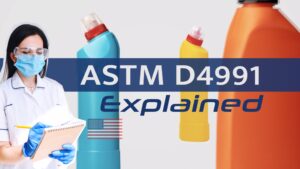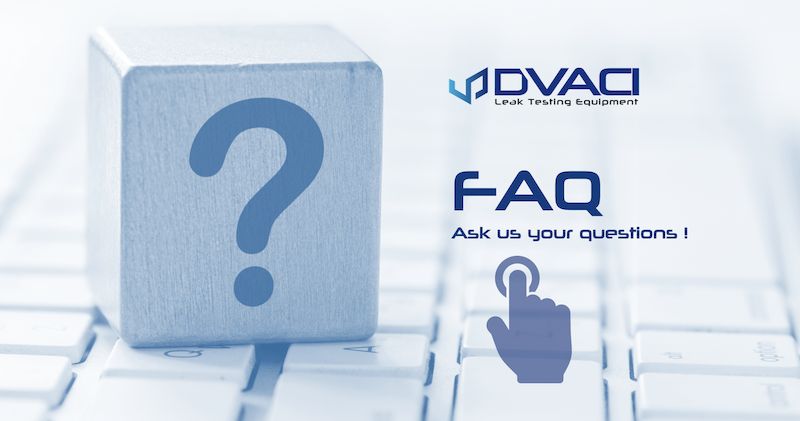Don’t hesitate to ask us your questions by filling out our contact form.
FAQ – Frequently Asked Questions
Sum up:
ASTM D4991 is a standard test method for testing empty rigid containers for resistance to leakage under differential pressure conditions such as those that may occur during air transport.
 The test involves pressurizing an empty container by immersion in an ethylene glycol-water solution in a transparent test chamber and subjecting it to a gradually increasing partial vacuum. The container is observed for signs of leakage, as evidenced by escaping air bubbles during depressurization or fluid in the container after re-pressurization.
The test involves pressurizing an empty container by immersion in an ethylene glycol-water solution in a transparent test chamber and subjecting it to a gradually increasing partial vacuum. The container is observed for signs of leakage, as evidenced by escaping air bubbles during depressurization or fluid in the container after re-pressurization.
The test method provides a limit of approximately 95-kPa (13.8-psi) differential for establishing the point at which leakage commences. The standard covers testing of rigid containers intended for the transportation of hazardous liquids in accordance with UN TDG and ICAO TIs.
Why to use the ASTM D4991?
This test method is important because it helps to ensure the safe transportation of hazardous materials by air. If a container fails the test and leaks during transport, it could potentially cause harm to people or the environment. By testing containers before transport, it reduces the risk of accidents and ensures that hazardous materials are transported safely.
Test Report:
The report should include identification of the containers and closures, total number of specimens tested, number of specimens tested at one time, test pressure requirement, whether test was performed at ambient temperature, whether test specimens passed or failed the test, whether each test specimen leaked and at what pressure differential, whether test fluid was apparent in each test specimen after testing, a statement to the effect that all tests were made in full compliance with the requirements of this test method, or noting any variations and detailing them, and the name and address of the testing agency, the date, and the signature of a responsible representative of the testing agency.
DVACI comes from Spanish “Cámara De Vacío” which means “Vacuum Chamber” in English. The initial idea was to call the brand DEVACI, but the “.com” domain name was already taken, so we opted to drop the E and stick with a short 5-letter domain name “dvaci.com”. We were lucky as 5 character domain names are usually not available.
No, this is not possible.
All options must be ordered at the time of purchase.
Our CDV Vacuum chambers comply with the European directives on which they are based, i.e.
- EN 61326-1:2013 electromagnetic compatibility
- EN 61010-1:2011 / A1:2020 electrical safety.
These two directives lead to the CE marking of the device.
These 2 directives have been verified by the Spanish laboratory: APPLUS located in Barcelona.
Our CDVs equipped with Orion (PLC version) or Pharmaceutical CDVs comply with USP chapter〈1207.2〉 Container Leakage Testing Technologies – Probabilistic Leakage Testing Technologies: Bubble Emission and Liquid Tracer.
Due to the depressurization that occurs in the cabin / hold of the aircraft.
In fact, airlines reduce the pressure by about -250mBar during air transportation. This is to minimize the cost of pressurizing the aircraft and to reduce mechanical stress on the aircraft. The same thing happens in the cabin where you travel.
Therefore, your container is under less pressure than its packing altitude, causing it to expand because the internal pressure balances the external pressure.
It is this principle of pressure difference that we use in our boxes. We can simulate air transport by putting a vacuum of -250mBar on your container and leaving it for a long time to simulate real air transport.
In order to be able to see the flow of liquid in the chamber it is best to test products containing liquid dry in our chambers.
Products containing liquids often need to be tested “upside down” to ensure that any air remaining in the container does not escape first… The entire part of the product likely to leak must be in contact with the liquid.
Some products that contain very little air can be tested lying down, but you have to make sure that the air is not in contact with the parts that can leak…
Yes, there is no problem to test the rigid containers, the stresses will be even higher in the sealing part. The difference in pressure between the inside and outside of the container will allow the test to be carried out with very good results.
In fact, these two versions are very similar and the differences are not obvious.
The PLC version, which is the highest range, has a complete “ORION OS” operating system that allows you to install applications to control the products in different ways, such as on a smartphone.
This version also includes a multi-user system that guarantees the isolation of each user session and allows each user to customize their interface and test programs
This version also allows us to connect a card reader Optional SD cards to export results. A printer to print test results and a barcode reader to quickly select the right test program for the product.
All our units are supplied with a cover system guided by 2 hydraulic cylinders to facilitate opening and closing. These cylinders act as shock absorbers.
This system prevents possible injuries that could result from handling a conventional bonnet without these “shock absorbers”.
DVACI brand appliances are designed and manufactured in Mexico in Querétaro by BOUSTENS SA DE CV.
At the beginning, in 2010, there was a legal structure in France called BOUSTENS SAS that was closed when the legal structure “BOUSTENS SA DE CV” was created in Mexico in 2011. So the company is incorporated in Mexico but the capital is of French origin. .
Currently, BOUSTENS focuses 100% on the manufacture and marketing of products and services under the DVACI brand.
Most distributors are listed in our Distributors and Partners section by clicking on the image. They are classified by country.
To better guide you and have an efficient follow-up of your request, we invite you to fill out our contact form.
You should know that sachets are packages that present several difficulties in terms of leakage testing:
1- Lack of Air
Generally, there is little air in the sachet, so this can cause 2 problems at the moment of leak detection:
1-1 When we do the immersion test in a vacuum chamber → ASTM D3078, we may not be able to create enough pressure difference on the walls of the package to be able to observe the leaks. This will depend on the size of the sachet and the volume of air remaining inside.
1-2 Even if the conditions are ideal for testing in a vacuum chamber, if a leak occurs, only a few bubbles will escape from the bag for 5 to 10 seconds. The pressures will quickly equalize and all the air will have been sucked out. So the operator must be attentive and observant. → The test becomes very subjective.
Solution: Do the test by injecting air -> internal pressurization in the sachet (bag) with a needle: ASTM F2096 standard
2- Low viscosity index of the product
The other difficulty is the product it contains.
The lower the viscosity index of the product (gel or peanut butter), the more likely it is that the product itself will block any leaks and prevent the expulsion of air (bubbles) or the flow of product. This phenomenon is unfortunately difficult to detect. The only solution is to do validation tests with empty products or with a product with a higher viscosity index.
So you will have understood, it is not simple.
If it suits you, I can quote you a CDV2 vacuum chamber (28x20x20cm) SVVI (SemiAuto, Vacuum, Venturi, Immersion) with PI option (Internal Pressurization). So you can do tests according to the D3078 and F2096 standards.
We have published some videos on Youtube that show how you can perform a leak test on sachets:
🎥 https://youtu.be/_1ErmBGiyVU

